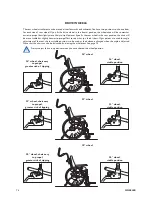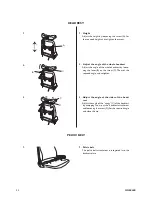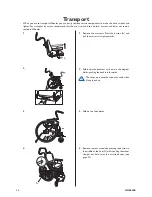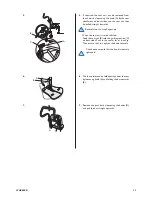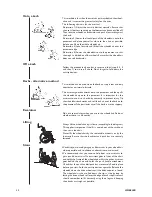
30
WHEELER
31
WHEELER
Onto a kerb
This method is for when the assistant is always behind the wheel-
chair and it creates the greatest safety for the user.
The following advice is for the assistant:
Illustration 1) Adjust the anti-tip devices upwards. Ensure that
the user’s feet rest securely on the footrests and cannot slide off.
Then lean the wheelchair backwards and push it forwards against
the kerb.
Illustration 2) Lower the frontal part of the wheelchair onto the
pavement and place yourself as close to the chair as possible,
before you lift up the whole wheelchair.
Illustration 3) Lean forward and lift/roll the wheelchair over the
pavement edge.
Illustration 4) Lower the wheelchair onto the pavement so that
the weight is divided on all four wheels. Ensure that the wheelchair
does not roll backwards.
Off a kerb
Follow the procedure above, but in reverse order (step 4, 3, 2
and then 1) to move off a kerb. Don't forget to fold down the
anti-tip devices.
Kerbs - alternative method
This method can be used when the kerb or step is low and only
constitutes a minimal obstacle.
The assistant goes backwards onto the pavement and then pulls
the wheelchair up onto the pavement. It is important for the
assistant to use his or her body correctly to prevent injury. Tip
the wheelchair backwards and roll the chair over the kerb onto
the pavement. Take particular care if the kerb is wet or slippery.
Escalators
Do not use escalators when you are in the wheelchair. Find out
whether there is a lift nearby.
Lifting
Always lift the wheelchair by its frame (according to the diagram).
This applies irrespective if the lift is carried out with or without
the user in the chair.
Never lift the wheelchair by the removable armrests or by the
footrests. Ensure that the backrest and push bar are securely
fastened.
Stairs
We advise you to avoid going up or down stairs in your wheelchair
where possible, and to choose an alternative route instead.
We recommend that you receive help from two assistants to
get up and down stairs. One assistant goes in front of the chair
and holds the frame of the wheelchair, whilst the other assistant
goes behind the chair and holds the push handle attachment.
Check that the push handles/push bar are securely fixed in place
before you start. Fold the anti-tip devices upwards. Balance the
wheelchair on the drive wheels until the balance point is found.
The wheelchair is then rolled down the stairs, step by step, by
letting the drive wheels roll over the edge of each step. Assistants
should remember to lift correctly, using their legs and keeping
their backs as straight as possible.

